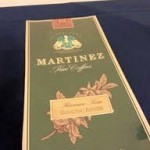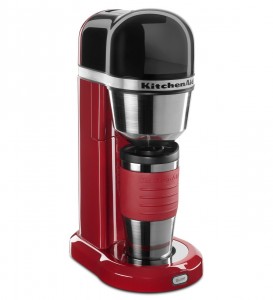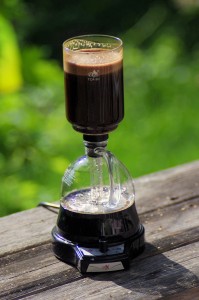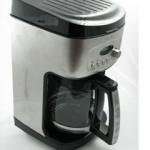by Coffee Kevin | Oct 25, 2013 |

Congresswoman Jan Schakowsky D-IL, Event Sponsor and I grab a cup and chat about, what else? CoffeeCon 2014!
During the recent National Coffee Association Summit in Philadelphia, I discovered the NCA planned a one-day coffee event for Congress to help bring attention to coffee and coffee issues. The NCA’s Donna Pacheco seemed to have everything planned, but when I volunteered she graciously suggested I might be able to discuss coffee with the Congressional staff who attend.
The issues in coffee are pretty straightforward. I think most everyone shares them. NCA CEO Robert F. Nelson would probably say the coffee industry wants to be more or less self-regulating, like the cosmetics industry. Doesn’t it make sense that the folks who know the most about how to proceed are those closest to the situation? How much labeling do we really need on one of the world’s oldest products? Think of the apple (fruit, not iPod). Do you really need or want nutrition information stamped on your apple? Is it worth the cost? And coffee, with things like caffeine content varying widely depending upon variety and roast, would impose an entirely new cost on the roasters, which of course hurts the smallest guys most. Does a centuries proven safe beverage like coffee really required to be treated like a laboratory-fabricated energy drink?
Also, how about some immigration reform ala coffee? Isn’t coffee that’s brokered, stored, roasted and brewed in the US entitled to be called Made in USA? These are issues the industry wanted to get across. I decided my role was best served by listening and observing first. Second, if asked I would talk brewing and consumers.

500 Congressional Coffee drinkers. There is hope, America!
I did wish to stump for more relationship building from seed to cup. I can’t think of a more potentially useful group to help with this than the State Department, who is charged to look for ways to improve communications with our neighbors, many of them coffee producing nations. CoffeeCon’s mission is to build a kind of “farmstand rapport” between U.S. consumers and their favorite coffees’ farmers. I know it’s possible. In CoffeeCon v.1 I recall posting on Facebook, offering a free booth to any farmer able to make the journey to Chicago. Honduran farmer Gerardo Casco came and exhibited and spoke to our attendees. It adds a global dimension to CoffeeCon and closes the loop from creator to consumer many in the industry speak about.
Coffee On the Hill (I know I keep calling it Coffee For Congress) was well attended. More than 500 shared coffee with us. The top-end coffee Barista Guild Chair Trevor Corlett and his fellow Madcap colleague Ryan Knapp ran out of the Cup of Excellence coffee they brought – I take some blame for this because I kept touting the coffee and downing several servings myself. Beans wise, I can’t help my own affection for John Martinez’ Honaunau Estates Kona Coffee beautifully represented the best of U.S. grown coffee.

I brought the rarest and best USA coffee: J Martinez Kona Honaunau!
Steve Schulman of S&D Coffee brought enough of their coffees for a representative world flight that featured some genuinely rare breeds, brewed with Bunn-supplied brewers, all organized and brewed to precision by Bunn’s Debbie Russell. There were also cuppers who set up stations from Coffee America (USA), Corp., Massimo Zanetti Beverage USA, and Noble Americas Resources Corp. They are to be commended for bringing the high degree of professionalism. Frankly, I didn’t expect to see replicas of coffee evaluation that trade uses. It added a nice Mr. Science touch to the proceedings. Note to self: See if these guys will come to CoffeeCon 2014.
As you can see in photo 1, I met Congresswoman Jan Schakowsky, D-IL who sponsored the event. She’s asked if I can bring CoffeeCon to her district, and of course the answer is a solid… maybe – haha, I learn fast here! I also met Congressman Darrell Issa, R-CA who of course is politically opposite of my Illinois Congresswoman. Typical of elected officials I’ve met, both were charming and engaging. I met many congressional aides, who all wanted to know which brewer, how to use it, and what my favorite coffee was. I spoke eloquently on the first two and diplomatically, even evasively on the last. Which coffee is my favorite? Hmmmm. (I told you I wished to show myself a fast learner. haha.)
I believe the event was a success in all ways. So, to answer an obvious inside joke: Did we energize Congress? Hmm. Let’s just say they left energized. Certainly it was great fun.
PS: Special thanks to Joe De Rupo, National Coffee Association Communications and Media Director for making it so easy to attend their events, and for snapping my photo with Congresswoman Schakowsky.
by Coffee Kevin | Jun 25, 2013 |

After a couple of no hitters, Kitchen Aid knocks it out of the ballpark with this one! Makes great coffee, attractive and flexible.
It seems everyone wants a personal coffeemaker. A few years ago I recall going to the International Housewares Show and seeing a few machines trying to be K-Cups without infringing on their ironclad patent. Now, every manufacturer has a horse in the single-serve race. Most of them are the opposite of a manual pourover such as the Hario V60. Most are mediocre at best, as is the Keurig’s original K-Cup. They underextract because they try too hard to be fast or their puny heating elements can’t get the water hot enough to extract coffee’s precious oils efficiently.
The KitchenAid Personal Coffeemaker is their entry into this competition and I am delighted. It does almost everything right and nothing wrong. Let’s look at each feature and then its measured performance.
1-4 cups! Most single serve machines are just that… one cup. The KitchenAid offers a range. Although it’s listed as a three cup, I was able to fill the water to maximum and get four full (near) five-ounce cups. This is just about perfect for me and a friend, three friends if we each want one cup. It’s easy enough to brew again if we’re really thirsty.
The KitchenAid Pers0nal Coffeemaker brews into a supplied to-go travel cup with a tight fitting lid, which doubles as a carafe. This shows their awareness of the market, because likely lots of folks are making their cup to travel. The personal brew size can be between six and 18 ounces. I always brewed maximum and I think you should too. I’ll tell you why in a moment.
There is a permanent gold filter, one that’s dishwasher safe.
The water container is removable. I couldn’t care less about such things but you may and it does make it easier to fill at the water tap.
Now to the tests: I always made a full batch. It is because drip makers are optimized for a certain grind and grounds-to-water ratio. At maximum fill the brewing contact time between water and the coffee grounds will be six minutes. If you brew less, that time shortens, and so does the strength unless you play with the recipe or the grind. Possible, but I say learn to make it one way and stick to it.
Most coffeemakers do not get the water hot enough. The Kitchen Aid single serve gets the water to 195°F, or higher. It takes about a minute to reach altitude but once it does, it stays there. The full-size Technivorm KB741 is ruler flat 200° but the KitchenAid is close enough that most of us won’t care and it shows you the company this one keeps.
Another failing of many drip makers is the ability of the showerhead to thoroughly and evenly soak the grounds beneath it. This means a lot because dry grounds don’t give any flavor to your cup. You waste fuel as they say in Car and Driver. If you use the kind of coffee I used to test this brewer, such as Dark Matter’s Cup of Excellence Colombian, you will see how important it is to realize the value of your coffee through thorough extraction. The Kitchen Aid is among the best automatic drip machines yet tested in the ability to soak the grounds. It is as good as the full size Bonavita, which leads in this category. Both it and the Kitchen Aid beat some other highly rated and costlier makers.
The brewing contact time is critical because your cup’s flavor depends upon exact extraction. When people complain of bitterness in their coffee, it is most likely due to a too-long contact time. The Kitchen Aid accomplishes its mission within six minutes. This is perfect. Shorter risks underextraction and less taste and even potential sour notes. Longer risks bitterness as I wrote above.
I know some of you are saying, “Kev, I have a Keurig and I have an insert that takes regular coffee. How is this new KitchenAid better?” Fair question. Even assuming the K-Cup King met the other parameters of time, temperature and water contact, the Keurig and in fact all K-Cup machines use a non-standard grind, an extremely fine one. It’s the only way it can give a decent extraction within the comparatively short contact time and meager grounds-to-water ratio. It’s hard to match, assuming your home grinder can do it at all. The KitchenAid Personal Coffeemaker uses a standard automatic drip grind. To me, it’s a no-brainer. And my tests confirmed the quality that went into KitchenAid’s design.
In addition to the great tasting Cup of Excellence, I tasted Jim’s Organic Coffee Wonder Brew blend. This is a darker than normal roast for me, but Jim did a nice job turning out a roast that can be described as syrupy but no over-roasted notes or excess caramelization, common side effects of darker roasts. I tried some of Counter Culture’s Banko Gotiti Ethiopian Yirgacheffe. My friend Rich Futrell recommended it so highly and it was the end of bin so I grabbed it. This coffee is a floral bouquet and it will taste good in almost any decent machine but a great one will give you the fruit in balance with the body. Otherwise fruity coffees can easily taste unbalanced to me. The Kitchen Aid acquitted itself admirably, producing a cup right on part with the previous day’s Chemex of the same bean, quite a feat!
Glutton for great coffee that I am, I happened to have another Ethiopian Yirgacheffe from Metropolis on hand to research some summer coffees to recommend to Men’s Health Magazine’s Diana Stanczak for a coffee article she was writing. This coffee is almost as bright as Counter Culture’s Banko Gotiti, and to be honest, I wondered if I’d be able to discern a difference between two same-region coffees in an automatic drip machine. The KitchenAid Personal Coffeemaker brewed batches that exhibited some subtle differences, likely as much due to roasting differences as their growing and processing distinctions. This was actually the test that proved to me more than any other how fine is this brewer.
The KitchenAid Personal Coffeemaker is a winner. This is the machine I’ve been waiting for since their legendary four-cup, long discontinued. If anything, the new one is superior. The four-cup never attained the same brewing temperatures.
KitchenAid knocked it out of the ballpark with this one. Highly recommended.
by Coffee Kevin | Jun 5, 2013 |
 This is as much a story about social media as a coffee brewer review. I first read about the Diguo TCA-C3 Siphon in a post by its Chinese manufacturer on LinkedIn. I was instantly enthused and invited them to CoffeeCON 2013. Next thing I knew they brought the spanking new brewer to CoffeeCON 2013, where is was a definite attention getter. The Diguo TCA-C3 is a glass siphon that makes three five-ounce cups of coffee. This is about one cup short of idea, but it’s perfect for a couple of cups of coffee.
This is as much a story about social media as a coffee brewer review. I first read about the Diguo TCA-C3 Siphon in a post by its Chinese manufacturer on LinkedIn. I was instantly enthused and invited them to CoffeeCON 2013. Next thing I knew they brought the spanking new brewer to CoffeeCON 2013, where is was a definite attention getter. The Diguo TCA-C3 is a glass siphon that makes three five-ounce cups of coffee. This is about one cup short of idea, but it’s perfect for a couple of cups of coffee.
Everyone’s calling them siphons but they have been known as vacuum makers for many years. The concept is: Water is heated in a sealed lower container. As it heats the steam pressure forces near boiling water up through the center tube into the upper bowl. The upper bowls mixes with grounds in as the pressure from the lower bowl keeps feeding it air bubbles, resulting in a nice agitation during brewing. When the heat shuts off the brewed coffee returns through a filter, in this case cloth, and the brew is hot, almost too hot, but beautifully extracted. Vacuum brewing is among my favorite methods. I chose it to demonstrate in my Coffee Brewing Secrets DVD released five years ago.
What’s new – The Diguo TCA C3 offers semi-automatic vacuum making. This is great because if you’re used to heating one up using an alcohol lamp, you already know how long it can take. The procedure with this unit is easy and straightforward.
How to use it – You simply put fresh water to the fill line in the lower bowl. Then turn the dial up to maximum to start heating the water. While it heats up, take the cloth-covered metal filter and install it, using the spring to secure it to the inside of the upper bowl’s tube.
At just over five minutes you’ll notice bubbling in the lower bowl, the water is at or near boiling. Once it boils, Lower the temperature dial to about half way (12:00 o’clock) and put the two bowls together. All this takes longer to write than to do. I’m sure I’m over communicating but after a couple of times you will find it easy to perform.
Once the bowls are joined and sealed, the water from the lower one will start rising into the upper bowl. Once the water has risen into the top bowl, add the ground coffee. Be a little careful if the coffee is ultra fresh as it may foam up and cause a messy overflow. If it does this, know that it’s happened to everyone who uses a vacuum method at least once.
The moment the grounds and water are in contact, start noting the time. Also start stirring the grounds and water together with the supplied stirring rod/scoop to facilitate mixing and to ensure the grounds all come in contact with water as soon as possible, as they grounds cannot being extracting their oils until they are wet. At just before 3 minutes contact time, shut off the heat power completely. The coffee will continue sitting up there and bubbling for around 10 to 15 seconds as if nothing’s happend – it takes a moment for the bottom bowl’s air to cool enough to contract. Then the finished coffee will begin its descent through the filter and into the lower bowl.
The coffee will be sucked back down through the cloth filter, hence the term vacuum. Once the coffee is completely down in the lower bowl, carefully remove the upper bowl (it is hot and may even be slippery) and place it in the black lid, which when turned upside down is a stand.
If all this was done right, it took a total of four minutes for your coffee to be extracted, perfect for the fine grind you chose. You are ready to enjoy your coffee.
If you’ve never had siphon coffee you’re in for a treat. Unlike drip method the grind is only used to expose more surface area. It does nothing to control contact time. Freed of this second responsibility you can experiment with different grind sizes to suit your palate. I use a quite fine grind.
My tests were performed with lighter roast coffees. I had Metropolis Coffee’s Sulawesi and reliably made many batches. It seemed each time I made three cups, a fourth person would show up and I’d make another batch, which allowed me to test consistency. Overall it was very consistent as long as I followed the same procedure and timing. I called it semi-automatic because you are required to shut off the temperature control when you wish to coffee to be done. I realize for some this will be a deal breaker. They are entitled but they are missing a much better cup of coffee, night and day superior to a Keurig machine and matching the best pourover.
A siphon cup differs from a pourover drip cup in the following ways:
- Hotter beverage temperature. If you like a steaming hot cup of coffee or find a Chemex cup too tepid to add cream, you’ll appreciate this.
- Heightens acidity, but never acrid-tasting. If you’ve found some lighter roasts too bright and acrid (sour) tasting you may find the higher overall brewing temperature of siphon brewers maintains the cup brightness minus that acrid note that I think is more pronounced when brewing at lower temperatures.
- The cloth filter matches the superclean mouthfeel of the best paper filter (think: Chemex) but with just that slight extra viscosity you can only get using cloth and that paper filter manufacturers keep trying to emulate doing things like poking micro holes into their filters.
The darkest coffee I used was Oren’s Sumatra. This is my favorite Sumatra Lintong ever from Oren. I was beginning to think he and I had a different idea of what’s perfect for Sumatra taste and then I took a sip of this coffee. Those who fear the siphon will be overlit or harsh due to the powerful air infusion during contact time can rest easy. It’s just a perfect cup. While I didn’t have anything resembling a French roast or darker during my test phase, I wouldn’t hesitate to try it out. However, if you’re a dark roast fan, I suspect you will find non-turbidity Presses or the Sowden SoftBrew will be more your cup of… coffee.
The last piece of maintenance advice is a bit of a hassle but I assure you it’s worth the hassle. Thoroughly rinse your cloth filter after each use, perhaps with a drop of Dawn or Free and Clear dish detergent just to enzymatically remove any traces of coffee oils. Cloth filters get rancid easily, their main drawback. You need not disassemble it. Keep it tucked away in a water-filled glass jar in the refrigerator. Never let it dry out.
Highly recommended to the coffee aficionado.
by Coffee Kevin | Mar 8, 2013 |

The Scoop: A true one-cup at a bargain price.
The single-cup coffeemaker is currently the marketplace Holy Grail. It makes sense. More people are drinking coffee for taste, not just energy and as they slow down to enjoy it their coffee, it makes sense to drink less at one sitting. Also, we who buy high-end coffee start noticing the extra cost of making a full pot, one that in my case would go to waste after a couple of cups. Pod machines are inherently inferior because the pre-packed pods cannot be fresh, not to mention their increased waste.
The ideal solution is a machine much like the Hamilton Beach’s The Scoop. The concept is perfect: A brewer that creates one or two perfect cups. One cup is 8 ounces, so its maximum yield is 16 ounces. It’s designed with this clever reverse cup stand which moves a smaller cup closer to the spigot. I actually like the hobo pour you get from a more distant relationship, but no matter.
This is a frustrating review. Why? Because Hamilton Beach’s new The Scoop coffeemaker is so close to perfect and yet so far.
Drip makers almost never work at two cup sizes. A major part of brewing cup of coffee is how long the grounds and hot water are in contact with each other. When a drip machine offers two sizes, one of them must be wrong because the contact time changes.
The Scoop gets the water to 200°F right off the bat. I tested it repeatedly because I have rarely found a brewer that starts with the right temperature water. This one does, and it maintains altitude throughout the brewing. The brewing contact time is a bit short, even for the larger cup cycle. It takes from 2 to 3 minutes depending upon the size cup you choose. This alone would not disqualify it, especially if you could either increase the grounds or lengthen the contact time by grinding more finely. But you can’t.
When you use regulation brewing recipes for your coffee, it causes a backup. The only way to get this brewer to behave is to lower the grounds-to-water ratio, or use coffee so stale it does not expand when the water hits it, which presents other taste problems.
More bad news. It cannot handle truly fresh coffee. Fresh out-of-the-roaster grounds foam up. The Scoop has a cute but undersized grounds holder. The coffee gets nice and wet, but it has nowhere to go but up and that makes a mess. It can even cause a backup so bad that if overflows over the sides, which is otherwise well sealed.
My sample brews included Passion House Rwanda Dukunde Kawa, Kaffeeklatch’s Mocha Java and Oren’s Daily Roast Nicaraguan La Ampliacion , all wonderful coffees. The Nicaraguan La Ampliacion is a Cup of Excellence winner that sells for $30 per pound, a perfect justification for a single cup brewer because I do now want to waste a drop of it, much less make unneeded cups. No doubt, the Hamilton Beach was able to extract the ample acidity from this and the other coffees. The Rwanda’s Pomegrante notes jumped out of the cup. But, clean-up was a mess, and in each case I know these coffees have more flavor than this brewer was getting due to waste. Why? Because they are all fresh coffees and when they expand, the grounds swell up and this causes an overflow, underextraction and a mess.
The only way it worked was to make the smaller 8 ounce cup size and then the contact time is too short. The best extraction I got was using pre-ground coffee past its freshness date, what John Martinez would call dead coffee. My guess is they built this coffee around supermarket pre-ground coffee and perhaps even used smaller grounds-to-water ratios.
Remember, the coffee brewing recipe is 10 grams or on 2 tablespoon scoop for each six ounce cup.

Look at the sides and you'll see fresh grounds that foamed up and never participated in the brewing process. Sad, because otherwise The Scoop showed such promise. Will Hamilton Beach issue a 2.0?
Then you’ll have the brewer for that perfect one cup that really works and I’ll be the first to say so.
The two things I will not do is use less-than-fresh or less-grounds than the recipe calls for. Sorry, Hamilton Beach, not in my house.
Since it’s so close, I have some friendly counsel for Hamilton Beach. Retool it using a larger filter holder and issue The Scoop 2.0.
by Coffee Kevin | Feb 24, 2013 |
 Cuisinart 14 Cup Brewer
Cuisinart 14 Cup Brewer
Kevin Sinnott
I was excited to try a Cuisinart which has definite curb appeal. And, fourteen cups? WOW! That’s a lot of coffee. I’m sure Cuisinart was proud of the engineering triumph of putting so much yield into a fairly small size footprint. Ever a value champ, the Cuisinart adds a permanent filter, which I used. Not only does Cuisinart brew the largest size brew, it offers a special 4-cup setting. Cuisinart’s fit and finish is not quite up to Saeco’s — I had to jimmy the filter door to close properly. Its brewer intuition is user friendly, however. The charcoal filter is easy to insert. You literally drop it in and it places itself properly into position. The instructions counsel using SCAA measurements, 85 grams for a full fourteen cups. It’s like having the babysitter show up with a Bible in her hand. Everything looks good.

Nice touch…disappearing power cord!

Cuisinart’s got a good seal, good sprayhead, and good extraction.
Temperature — The unit takes its time to reach a credible brewing temperature. It took nearly three minutes to reach 180 degrees F. This is like a Boeing 747 climbout, which is slow. Worse, it never gets to altitude — the brewer, not the plane. It stays there through much of the brew cycle, rising to the bottom official brew temperature some ten minutes into the brew cycle. It peaks at 195 F at the eleven minute mark.

Contact time — The cycle takes a very long 13 minutes start-to-finish. That’s a long time to subject any coffee grounds to hot water, even when the water isn’t very hot.
The V-shaped filter means there’s a concentrated bottleneck where some coffee grounds are overexposed to hot water to begin with — which only increases bitterness.
Extraction — The grounds basket inspection revealed a good extraction of all the grounds to all the water. Too bad the other variables were poorly met, because the water flow design is obviously a good one.
Taste — The resulting brew reflects their attempt to temper long brew times with substandard hot water. The coffee was overextracted; bitter, and totally lacking in the refined flavor notes that should be present, especially given the healthy amount of grounds used. It was full-flavored but devoid of anything special. I tried a sack of Colombian coffee from Dunn Brothers in Minneapolis. This coffee was super fresh, which was an acid test of the brewer’s ability to not foam up due to Co2 degassing. No problem there, but the flavor was still bad. A Mocha Java from Salt Lake City’s Caffe Ibis, a great blend by the way, was just lost on this brewer. I know what both these coffees are capable of, so it was doubly disappointing.
CUISINART 4-CUP SETTING
I repeated brewing using the four cup setting. I put twenty-four ounces of water and 36 grams ground coffee and then pressed the four-cup button. The instructions promise “double heated” water. This double heated concept may work on paper, but it seems to generate just slightly earlier hot water, and the water never gets hot enough, reaching just short of 192 five minutes into brewing. The four cup setting gives a seven minute brew cycle, still long for manual brewing, but within reason for contemporary electric drip. Due to the very low early water temperature there was not evidence of bitterness in the final brew. It was actually decent tasting, but again with very little cup sparkle that a fine coffee maker would resolve. I used the same two coffees and each was better, but still far short of their potential.

Conclusion — Who tasted coffee from this machine before they brought it to market? Did they really bring this to a conference table, the executives tasted the coffee and they all shook hands and high-five’d each other. It just goes to show there’s no brand consistency. The grinder is great. Get a different brewer. If you do own one, I’d always try to use the four-cup setting, where at least a decent cup is possible.













